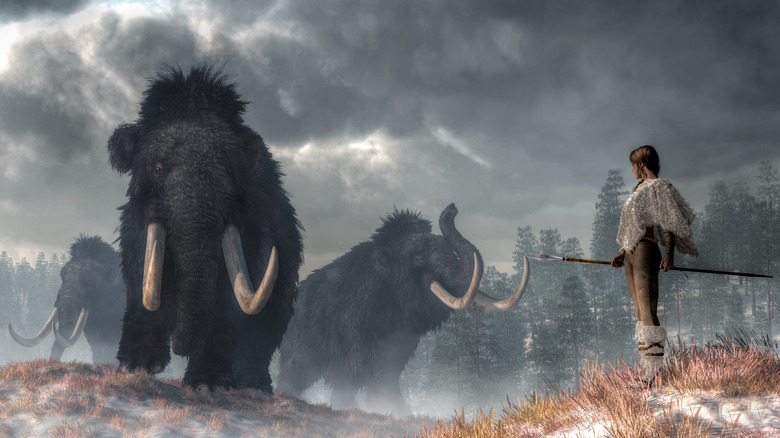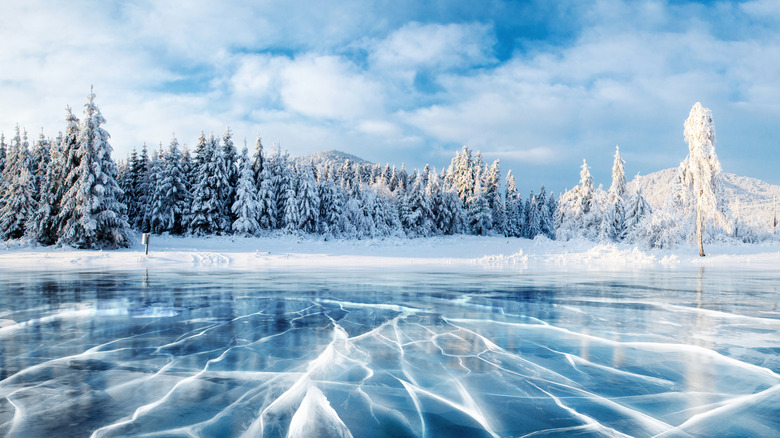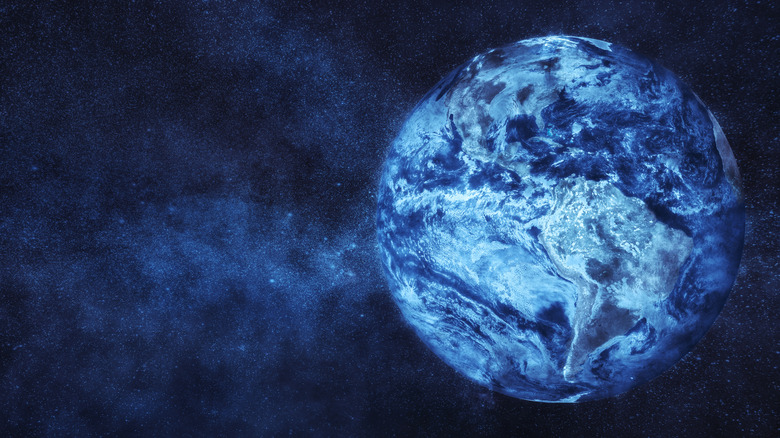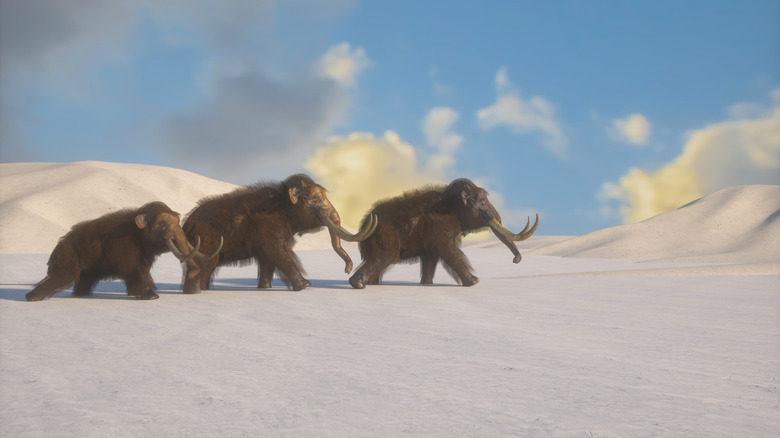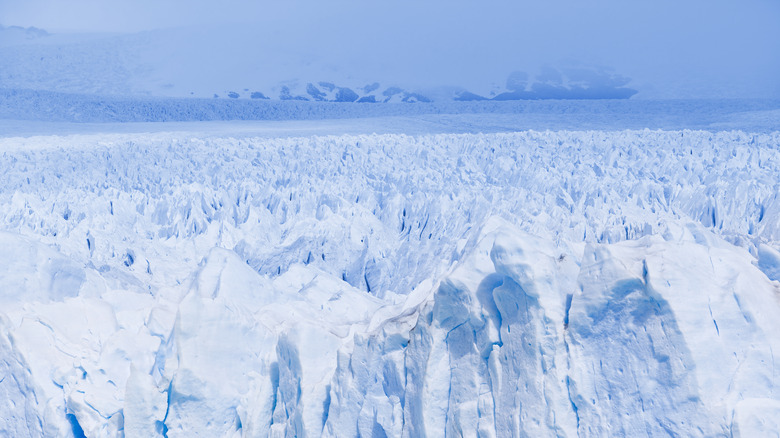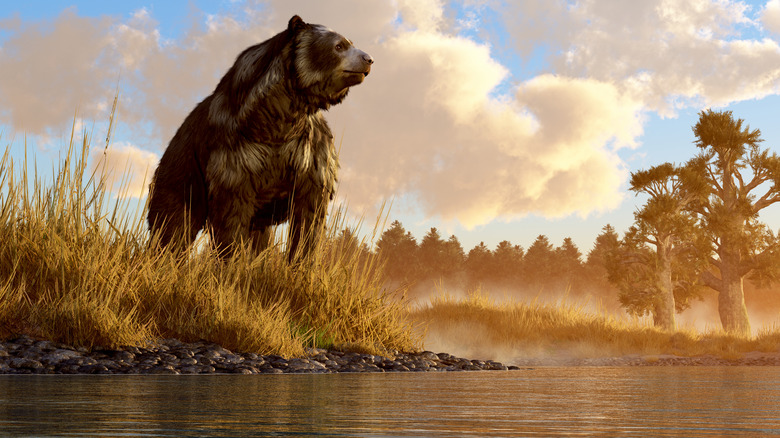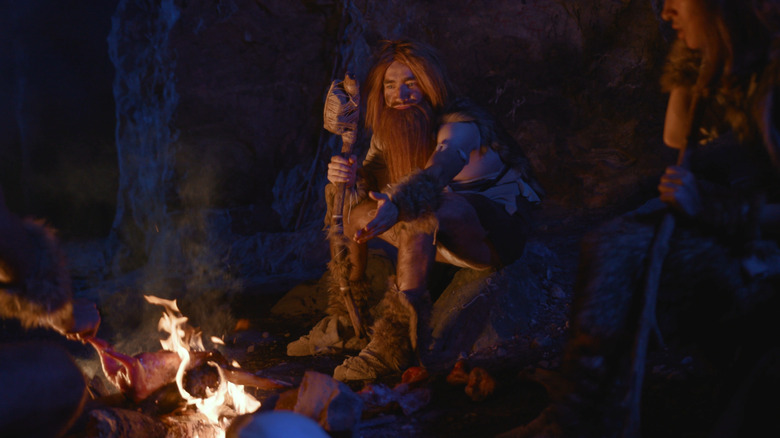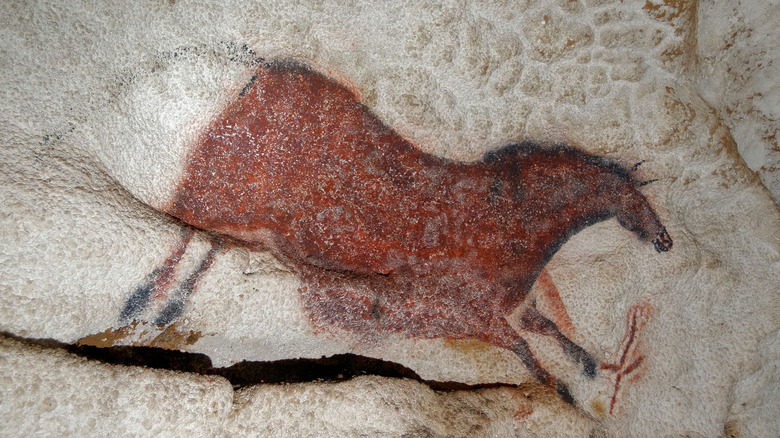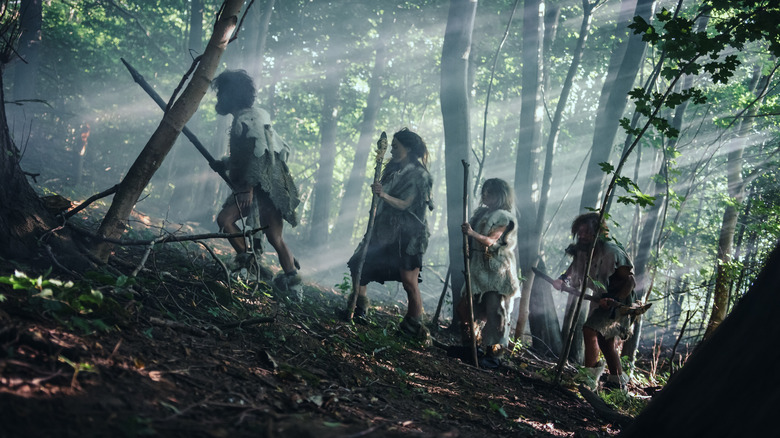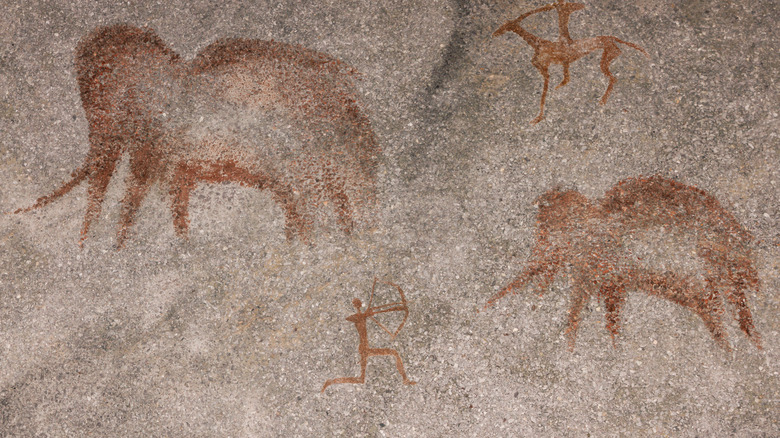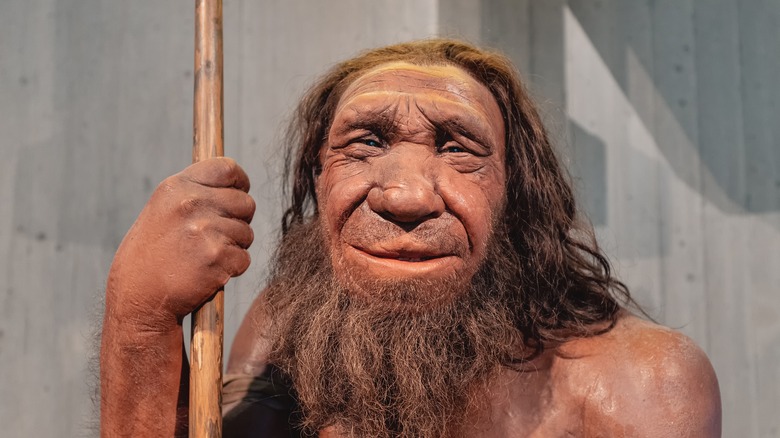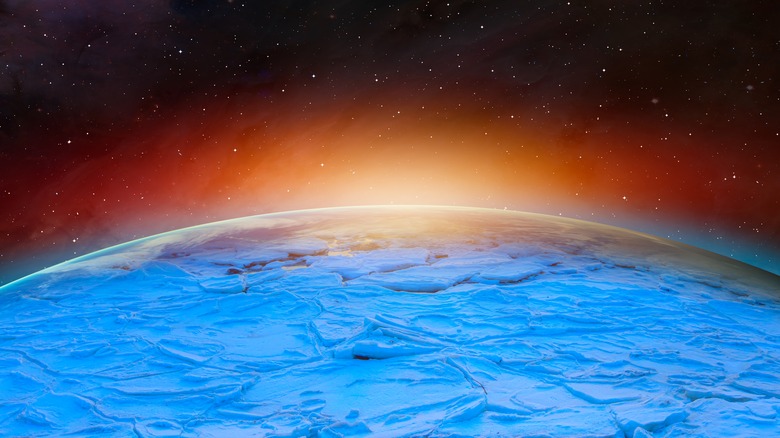Things You Get Wrong About The Ice Age
When someone mentions the Ice Age, you might first think of computer-animated animals voiced by comedians, trekking across a perpetually frozen landscape. Maybe you'll also recall a lesson plan your history teacher rushed through to get to something they found more interesting. As a result, many of us are woefully uninformed about what, exactly, the Ice Age was. It was... cold? Glaciers must have been everywhere, perhaps even across the whole planet when things were at their worst. There were large animals, too, woolly mammoths and huge cave bears hunted by people with low-tech spears and crudely fashioned fur clothing, probably.
Well, not really. Though some of those notions skirt close to the truth, they're not nearly good enough to give you an accurate picture of the complex landscape of the Ice Age. Turns out this period you thought was just a boring, featureless expanse of ice punctuated by a Neanderthal or two had a lot more going on. So, it's time to finally bust those myths about this part of the deep past. These are the things you've been getting wrong about the Ice Age.
False: There was just one Ice Age
People may speak about the Ice Age in a way that makes you think the planet has gone through a single, massive period of bitter cold. It sounds so monolithic, after all. And, given the way that media like film and television tend to depict a planet locked in the lifeless, frozen embrace of glaciers, there's no way life here could have made it through such icy doom more than once.
Actually, we have. The truth is that our Earth has so far weathered not just one, or two, but five known ice ages. Thanks to scientists who have closely studied climate data contained in geological features, ancient sediments, and ice cores pulled from frozen (and sometimes underwater) landscapes, we actually have a pretty good picture of when these various ice ages happened. The oldest one we know about happened in the planet's deep past, about 2 billion years ago, and lasted for 300 million years. As for the most recent ice age (which we often refer to as the capitalized proper noun Ice Age, further contributing to the confusion), that started roughly 2.6 million years ago and reached its coldest temperatures an estimated 20,000 years ago. What's more, we're technically still in its embrace, though scientific data makes it clear that the climate has warmed considerably over the last 20 millennia.
False: The whole planet froze
An ice age sounds pretty all-encompassing. Some of the more fantastic takes on the idea may have you believing that the entire globe was plunged into a deep freeze. Heck, do a bit of digging and you'll even find real scientists referring to a "Snowball Earth," so that must mean at least one of the ice ages in our planet's history was literally bone-chilling.
Not exactly. Yes, there's good evidence that a runaway cooling effect chilled the Earth multiple times, with two of the most major glaciation events occurring during the aptly-named Cryogenian Period 720 to 635 million years ago. During the coldest times of this period, glaciers crept across much of the planet — but not all of it.
A 2023 study published in Nature Communications showed that there were plenty of oxygen-sipping organisms living in a surprisingly wide zone around the equator during the Marinoan Ice Age 654 to 635 million years ago. If the planet had truly been encased in ice as the more fantastical takes on Snowball Earth might have you believe, then oxygen would have been in short supply in the iced-over oceans and there would have been less diversity and fewer lifeforms overall. Instead, the study's authors found that there would have been areas of open ocean that undermine the notion. It might be better, as some have argued, to think of these periods as Slushball Earth, even if that doesn't quite get thriller novelists scribbling away.
False: Ice ages are all cold, all the time
Ask a climate scientist what they really think about public perceptions of the Earth's climate, and they might sigh and tell you that people tend to indulge in absolutes. It's not just that certain senators have waved a snowball inside the Capitol to decry global warming, as Senator James Inhofe of Oklahoma did in 2015, forgetting that climate is a long game and yearly weather patterns are just short-term propositions. That sort of blunt thinking extends much further into the past, where the incautious might assume that ice ages are a constant thing. They must be all cold, all the time, or we wouldn't call them ice ages, right?
Of course, you're far smarter than that and already know that the climate trends in ice ages are way more complicated. In other words, ice ages contain multitudes, climatologically speaking. Data shows that they contain periods in which the temperature warms up and glaciers retreat a bit, known as interglacials. Periods in which the cold weather ramps back up and the glaciers begin to creep forward are known as — you guessed it — glacials. Local temperatures could vary by a significant amount, too. During the peak of the last Ice Age, about 20,000 years ago, average global temperatures were 10 degrees Fahrenheit lower than today's average. However, local temps in some regions were up to 40 degrees lower.
False: Ice ages move very slowly
The speed of ice ages may appear to be agonizingly slow. After all, a glacier can only move so quickly, right? It's not as if a massive wall of ice is going to surprise you by leaping down into the next valley. What's more, given the sheer area that a climate has to cover, there's no way an ice age can spring up on us or dip out of existence without taking its time.
But, taking a very long geological view where a millennia or two doesn't account for much, the truth is that ice ages can come on relatively slowly but may end pretty suddenly. Smaller variations in global temperatures can happen over very short time spans like decades, which are mere blinks of the eye as far as the planet is concerned. After the most recent glacial period was beginning to wane and temperatures were generally warming about 12,800 years ago, temperatures plummeted suddenly. Then, just 1,300 years after that, some regions saw average temperatures rise by as much as 20 degrees Fahrenheit over only a few years.
What's causing these relatively sudden climate swings? Some scientists have suggested that changes in the sun's output might have something to do with it, or perhaps shifts in ocean currents caused by melting freshwater glaciers. Others have noted that a wide array of incremental changes may build up and reach a sudden breaking point where it all changes at once.
False: All of the animals died
Popular conceptions of the most recent Ice Age tend to make things look pretty barren. Consider the modern Arctic, where seemingly endless and empty expanses of ice can surround you with a whole lot of nothing. Yet, take a closer look and you'll find plenty of life both now and at the height of an ice age.
For one, ice ages didn't really encase the planet in one huge ice sheet. Neither was it always bitterly cold, as evidence of glacial melting and refreezing makes clear. That means there were a variety of environments for living creatures to thrive in, even if the average global temperature was relatively cold.
Moreover, plenty of Ice Age animals did just fine in frozen environments, or even downright thrived in the relatively cool temperatures. Megafauna (large animals) like woolly mammoths, short-faced bears, and steppe bison did quite well in the cold, dry climate of the most recent Ice Age. About 20,000 years ago in Beringia, which includes the now-submerged area between Alaska and Russia, climate shifts encouraged the growth of nutritious plant life that supported large, hungry animals (and the animals that ate those herbivores). Large animals were also better adapted to moving around tundras; when forests became dominant in many warming ecosystems, it's telling that some megafauna appear to have been pushed out.
False: No one moved anywhere
When it's winter, cold temperatures and poor weather may force you to sit inside. However, humans who were around during the most recent Ice Age weren't so content to hang tight. In fact, it's pretty clear that, somewhere between 70,000 and 60,000 years ago, ancient humans moved out of the relatively comfortable climate of eastern Africa and started putting up stakes just about anywhere they could reach. This included actively moving through territory occupied by closely related Neanderthals and even beyond into icy, glacier-locked regions that no one else seemed all that interested in settling. Our species was very definitely on the move, Ice Age be darned.
The latest Ice Age even made travel quite a bit easier for some members of Homo sapiens, as glaciers that locked up water thereby caused sea levels to dip and land bridges to appear between distant locales. That included land bridges that may have allowed humans to make the crossing from what's now Siberia and into North America. The exact timing of that crossing and how it really happened is still hotly debated, including whether humans hoofed it, paddled along shores in boats, or even boldly took to the open sea. However it took place, emerging evidence hints that humans made it to the Americas as early as 20,000 years ago, just as the ice age was loosening its grip on the planet.
False: Human culture stagnated during the Ice Age
Ice Age humans weren't brutish and stupid, no matter how much old-school television or movies try to convince you otherwise. Sure, the image of a grunting human stumbling out of a cave and waving a club might make us feel good by comparison, but the truth is we should find a better way to feel good about ourselves.
Ancient humans were still Homo sapiens, just as we are today, and came with practically the same complex capabilities for problem-solving and art-making. Consider how archaeologists have uncovered well-appointed burials from the end of the last glacial period around 34,000 to 26,000 years ago, full of finely-worked beads and clearly laid to rest with great care by the living. Excavations have also revealed what appear to be temples and ritual objects, like those at Göbekli Tepe in modern Turkey, which contain hundreds of pillars covered in carvings. This site is about 12,000 years old, but it didn't spring up out of nowhere. Evidence like this points to a complex Ice Age spiritual life that set the stage for places like Göbekli Tepe.
Then, there's the art. Ice Age people were well versed in all kinds of art forms, including incredible cave paintings that can take your breath away thousands of years after the creators died. Ancient artworks that have survived over the many millennia also include carved objects of figures like voluptuous women, animals, and a lion-headed figure that's estimated to be 40,000 years old.
False: Humans were the only Ice Age hominids
Though we're the only confirmed hominids living today, our species wasn't quite as lonely during the last Ice Age. For a while there, modern humans (Homo sapiens) were alive at the same time as close hominid relatives including Neanderthals, Homo erectus, and the Denisovans. However, the last lingering population of Homo erectus appears to have died out in the relatively warm climate of Indonesia. They also faded away not long after the last known glacial period began to advance around 100,000 years ago, meaning they're really only Ice Age hominids on a technicality.
Some human relatives who did face the Ice Age were very well suited to the cold climates of some regions. Compared to modern humans, Neanderthal people were shorter and broader, with wide nasal openings and short limbs. Being more compact may have helped them retain body heat, though other scientists suggest that this body type may be the result of more random genetic happenstance instead of environmental pressure.
They may not have been perfectly adapted to Ice Age climates, either. Significant drop-offs in Neanderthal populations have been linked to a one-two punch of cold, dry periods around 44,000 and 40,800 years ago, according to a 2018 study published in the Proceedings of the National Academy of Sciences. As the environment around them changed, Neanderthals may have failed to adapt in time, opening them up to other pressures that contributed to their fading populations.
False: Human overhunting is solely responsible for Ice Age extinctions
The prevailing theory once held that many species of Ice Age megafauna went extinct after meeting humans with spears, often known as the overkill hypothesis. Yet, that's not the whole story. While humans wielding various weapons didn't help things, the fall of large Ice Age mammals is due to a complicated mix of factors.
For every creature in the ice age, there was the inescapable fact of the climate. It's not just that it was cold, but that things were subject to unpredictable change. A 2021 paper published in Nature Communications found that there was no significant long-term relationship between human and megafauna populations in late Ice Age North America, though there had been an estimated 80% drop in the number of large animal species by 11,700 years ago. However, climate evidence and statistical modeling does indicate that dips in temperature led to dents in large animal numbers.
An earlier study published in a 2020 edition of Nature Communications backs this up with on-the-scene evidence from ice age Texas, where a cold period was linked to a noticeable drop in plant and animal diversity. But while plants in the area of Hall's Cave appeared to recover when things got warmer during the Holocene, large animals in the area stayed gone. Though humans aren't off the hook entirely, it's likely that they weren't the sole culprits in the mystery of the missing mammoths.
False: Neanderthals died out totally during the Ice Age
As the last glacial period wore on, things were looking pretty bad for the Neanderthals. Though their stocky bodies may have meant that they were decently well adapted to the cold, it's also possible that colder climates in their European homelands helped to do them in starting around 40,000 years ago. With humans moving in — and maybe violently competing for resources, as we are wont to do even today — it must have been a total disaster.
Not so fast, say geneticists. If you carefully consider your genome, you might just find evidence of Neanderthal ancestors who didn't just survive alongside humans, but may have gotten far cozier with Homo sapiens. Genetic analysis indicates that, today, non-African people may find up to 4% of their DNA comes from Neanderthals. The figure may have been as high as 9% for humans living about 40,000 years ago.
So, though we can't rule out unfriendly interactions between humans and Neanderthals during the Ice Age, it is obvious that at least some of them were in very close quarters. While it's clear that time hasn't been especially kind to the Neanderthals — no one really has a Neanderthal neighbor or co-worker today, no matter what silly joke you have in mind — the evidence for interbreeding makes it clear that at least a few segments of their DNA are still around today.
False: We're on the precipice of another ice age
Given how hot the planet feels lately, it must seem like we're definitely done with the last Ice Age. We're actually not, given that we're technically still in the quaternary period, though many glaciers are shrinking thanks in large part to anthropogenic climate change caused by humans. Still, you might come across one last Ice Age myth that's oddly persistent: that we're due for another cold one.
This isn't about the last big ice age, really, but is instead more often linked to what's commonly called the "Little Ice Age," a time of relatively cold temperatures from the 14th century into the mid-19th century. But, though some northern European locals did freeze over on occasion, this wasn't much of an ice age at all. A 2017 report in Astronomy & Geophysics notes that the cool period was very short compared to real ice ages. Global temperatures weren't that far off the norm, anyway, especially when compared to climbing average temperatures that we've measured in just the past few decades. Fretting about things like decreased solar output causing a new ice age is, frankly, baseless. It might even encourage some people to ignore the very real effects of human-caused climate change that are dramatically changing our planet today.
